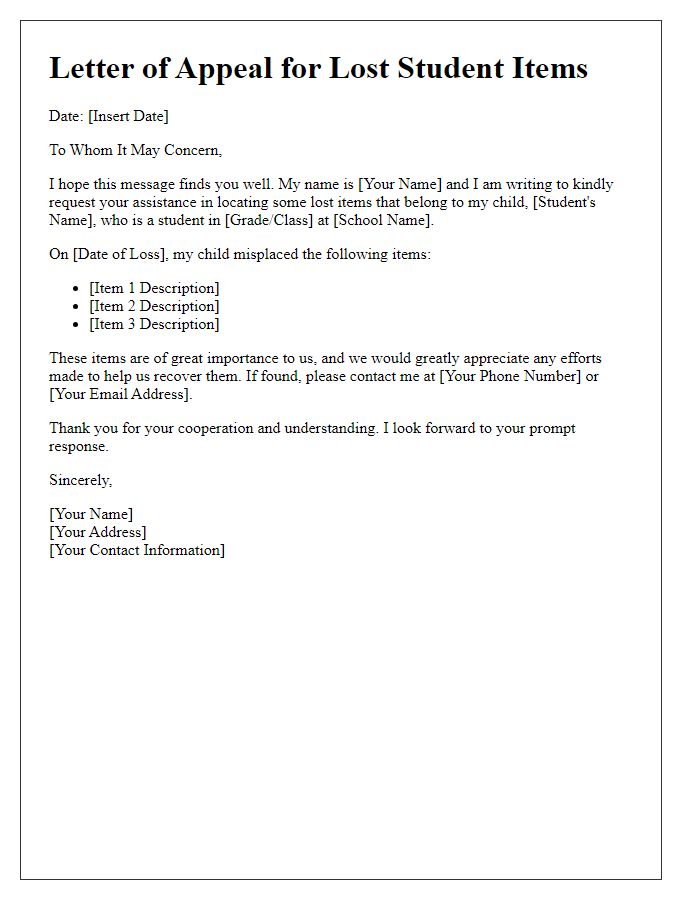Have you ever faced the frustration of losing something important at school? It's a common dilemma for both students and parents alike, with items often disappearing in the hustle and bustle of daily life. Luckily, most schools have a lost property system in place, but navigating it can be tricky. If you're wondering how to draft an effective inquiry letter to retrieve lost belongings, keep reading for tips and a sample template to help you out!

Clear Subject Line
Lost Property Inquiry at [School Name] The lost property department at [School Name] is responsible for items misplaced by students, staff, or visitors. This department typically manages a collection area where lost items are stored for a specified period, usually ranging from 30 to 90 days. Various articles such as clothing, lunchboxes, books, and electronic devices accumulate during the school year. When inquiring about lost items, it's essential to provide detailed descriptions, including specific colors, sizes, distinctive features, and any identifiable markings. The cafeteria, gymnasium, and common areas are often hotspots for lost belongings, making these locations vital for search efforts. Students are encouraged to regularly check the lost property collection area, especially after significant events like sports days, field trips, or school dances, where items are frequently forgotten.
Student Identification Details
Lost property inquiries at schools often require specific student identification details to efficiently locate and return lost items. Essential information includes the student's full name, grade level (for example, 6th grade), homeroom teacher's name, and student ID number (which could be a unique identifier like 123456). Additionally, providing specifics about the lost item, such as description, color, brand, and any identifiable marks, enhances the chances of recovery. Mentioning the approximate date and location where the item was last seen (like the cafeteria or gymnasium) can also aid staff in their search efforts.
Detailed Description of Lost Item
Lost property inquiries often pertain to valuable items that may have been misplaced in educational settings. Items like backpacks, often branded like North Face or JanSport, can have distinctive colors such as navy blue or bright red, and may contain important personal belongings. Water bottles, particularly stainless steel models from brands like Hydro Flask or CamelBak, can range from 20 oz to 32 oz sizes, often with unique designs or stickers. Clothing items such as jackets, especially popular styles like fleece pullovers or windbreakers, can feature logos like Nike or Adidas and may come in sizes ranging from small to extra-large. Electronics, including tablet devices like iPads or Chromebooks, often have identification numbers or usernames associated with school accounts, which can be useful for tracing ownership. Providing thorough details on these items assists in the recovery process, enhancing the chances of returning lost possessions to their rightful owners.
Location and Time of Lost Item
A lost property inquiry can provide essential details regarding the whereabouts of the item. The specific location where the item was lost (such as the school's cafeteria, gymnasium, or library) is crucial for facilitating the search. Additionally, including the time of the incident (for example, during lunch break at approximately 12:30 PM on a Wednesday) can narrow down the timeframe when the item may have been misplaced. This information assists school staff in organizing their efforts to locate the lost item, ensuring that students recover their belongings efficiently.
Contact Information for Follow-up
Lost property inquiries in educational institutions require accurate communication for resolution. Effective contact information ensures prompt follow-up regarding missing belongings. Include full name of the student, grade level, and specific details of the lost item, such as brand, color, and any distinguishing features. Home and mobile phone numbers allow for direct communication, while an email address facilitates written correspondence. Providing a contact time frame also aids staff in timely responses, enhancing the chances of recovering lost goods. Always check institutional policies on lost property for additional guidance.













Comments